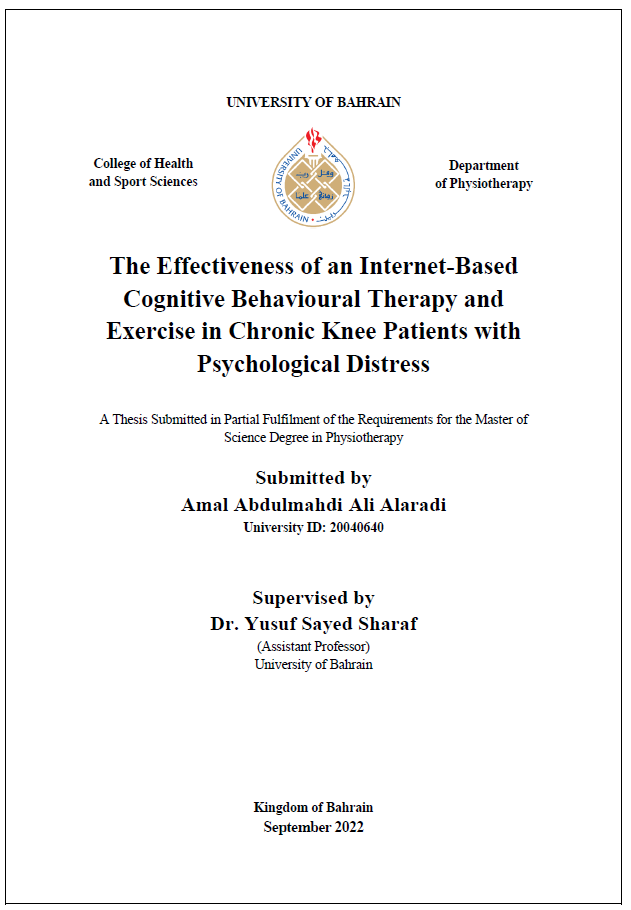وثيقة
المعرف
https://digitalrepository.uob.edu.bh/id/d3e7ac1e-dc70-4cf2-959d-657a15622c42
The Effectiveness of an Internet-Based Cognitive Behavioural Therapy and Exercise in Chronic Knee Patients with Psychological Distress
وكيل مرتبط
Sharaf, Yusuf Sayed , مشرف الرسالة العلمية
تاريخ النشر
2022
اللغة
إنجليزي
مدى
[1], 15, 129, 17, [1] pages
مكان المؤسسة
Sakhir, Bahrain
نوع الرسالة الجامعية
Thesis (Master)
الجهه المانحه
"""UNIVERSITY OF Pittsburgh , College of Health Sciences Department of Physiotherapy
الملخص الإنجليزي
Abstract:
Introduction: Internet-based cognitive behavioural therapy (iCBT) and exercises have
been used widely to treat chronic musculoskeletal pain. We aimed to examine the
effects of a combined iCBT with a standardized exercise program in chronic knee
patients with psychological distress.
Methods: This was a 2-arm quasi-randomized controlled trial of eight weeks of
intervention involving eight sessions of standardized exercise program and either
concomitant iCBT and educational sessions or educational sessions only.
Measurements were taken at baseline and eight weeks immediately following the
intervention. Primary outcome measures were a numerical pain rating scale, 40-m Fast-
Paced Walk Test, Step Test, and 30 seconds Chair Stand Test. Secondary outcome
measures were Patient Health Questionnaire, Psychological Distress, Knee Injury and
Osteoarthritis Outcome Score Physical Function Short Form, Health-Related Quality
of Life-Short Form-12, and Quadriceps Maximum Isometric Muscle Strength.
Results: Thirty-seven participants aged (Mean ± SD) 55.5 ± 7.9 years with chronic
knee pain at a certain level of psychological distress were enrolled. In the intervention
group (19 participants), there were significant differences in all the primary and
secondary outcome measures post-treatment. Furthermore, there were statistically
significant differences between both groups in pain levels (MD = 1.79, [95%CI 0.5 to
3.08], P=0.008), and step test (MD =- 1.74, [95%CI-3.38 to -0,9], P=0.04) favouring
the intervention group post-treatment. Yet, there were no significant differences
between both groups post-treatment in walking speed (MD = -0.07, [95%CI -0.24 to -
0.11], P = 0.449) nor in 30s CST (MD = -1.86, [95%CI -3.99 to 0.26], P = 0.084).
Lastly, there was no significant difference between the groups in any secondary
outcome measure post-treatment.
Conclusion: A combined iCBT and a standardized exercise program intervention can
effectively improve pain, function, patient's reported outcomes and the quadriceps
muscle strength in chronic knee patients with psychological distress. However, when
compared to a control group, only pain and step test had improved significantly. Future
studies should investigate the effects of the combined iCBT and standardized exercise
program intervention on a larger number of participants. Additionally, longer term
effects of the intervention should be investigated.
المجموعة
قالب العنصر
أطروحات

